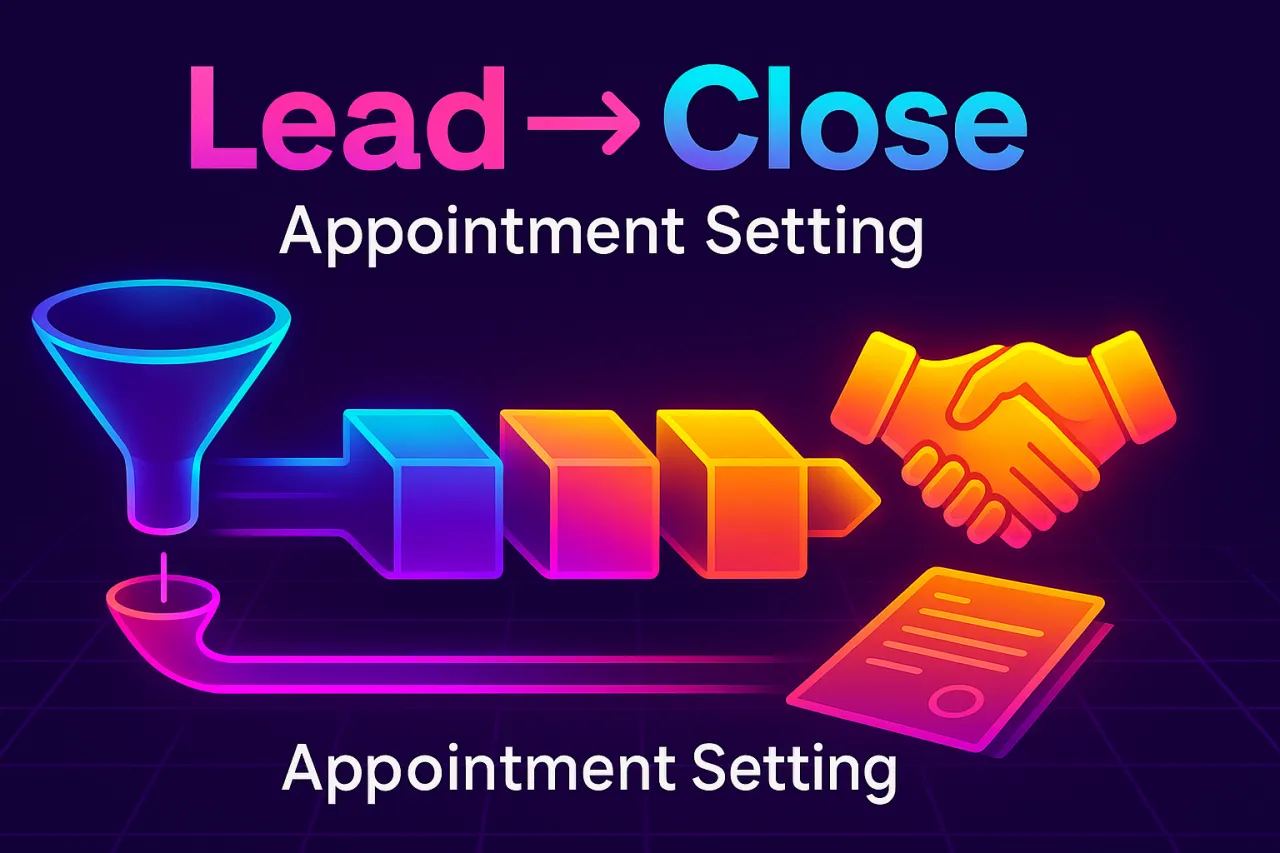When revenue teams complain about “leads that never turn into deals,” the culprit is rarely lead quantity—it’s the gap between marketing hand-off and the first real conversation. Appointment setting is the bridge that closes that gap, turning anonymous form fills or cold-outreach replies into pipeline you can forecast. And in 2025, the practice has become both more science-driven and more human than ever.
Why Appointments Matter More Than Raw Leads
- Higher conversion: Tech firms that build a formal appointment-setting motion see lead-to-opportunity lift of 50 percent or more compared with firms that rely on ad-hoc follow-ups
- Better close rates: A 2025 Forrester Total Economic Impact study found Salesloft users achieved 12 percent higher win rates after standardizing discovery-meeting scheduling
- Channel preference shift: LinkedIn connection requests now generate 10.3 percent average reply rates versus 5 percent for cold email, so reps who can book meetings where buyers already spend time win the first impression.
- Risk of “rep-free regret”: Gartner reports that 75 percent of B2B buyers say they prefer a rep-free experience—yet those same buyers are far likelier to suffer purchase remorse without human guidance. Timely meetings resolve that tension.
In other words, the fastest way to move a lead from curiosity to commitment is to get on their calendar—ideally within days, not weeks, of first touch.
What Exactly Is Appointment Setting?
At its core, appointment setting is a specialized sales function (often carried out by SDRs or an external partner) that:
- Identifies high-fit accounts and buying-committee members.
- Engages them via multi-channel outreach.
- Qualifies their intent, budget, timeline, and authority.
- Books a discovery or demo call directly on an account executive’s calendar.
Done well, it eliminates the “black hole” between MQL and SQL, so closers spend time only with prospects who have agreed to talk business.
The Science Behind High-Yield Appointment Setting
- Data-driven targeting
Deep-sales platforms use firmographic, technographic, and hiring-signal data to rank accounts by propensity to buy. Companies following this model see 14% higher win rates when timeline is discussed in the very first call. - Channel orchestration
Buyers toggle between LinkedIn, email, phone, and chat. The best appointment setters match that behavior: a LinkedIn note referencing the prospect’s latest post, followed by a concise email and a same-week voicemail. Omnichannel isn’t spray-and-pray; it’s sequencing touchpoints where each medium reinforces the previous one. - Hyper-personal messaging
Generic “just checking in” notes die in spam. Top teams tailor outreach to triggers—funding news, tech-stack changes, job moves—proving relevance in the first 50 words. - Calendar friction removal
Instant booking links, round-robin routing, and timezone detection collapse multi-email back-and-forth. In 2024 Belkins found that outreach sequences that end with a one-click calendar link convert 27% better than those that ask prospects to “let me know a good time. - Tight hand-offs
Qualified notes, call recordings, and CRM fields automatically pass to the AE so the prospect doesn’t have to repeat themselves. Momentum preserved = deals accelerated.
Where Appointment Setting Fits in the Funnel
| Funnel Stage | Primary Goal | Appointment-Setting Contribution |
|---|---|---|
| Lead Capture | Generate interest | Surfaces trigger events and intent data to prioritize high-fit names. |
| Qualification (SQL) | Confirm pain, budget, timeline | Live conversation booked within days; no more reliance on form fields alone. |
| Discovery | Map stakeholders & success metrics | SDR notes and call prep ensure AEs ask the right first-call questions. |
| Demo / Solutioning | Align on value | Meeting summaries and next-step scheduling handled before call ends. |
| Proposal & Close | Finalize terms | Setters circle back to late-cycle influencers, keeping the deal coalition intact. |
Five Action Steps to Upgrade Your Appointment-Setting Engine
- Map your Ideal Customer Profile (ICP)
Start with closed-won data: Which industries, ARR bands, and tech stacks bought fastest? Feed that back into list-building tools. - Adopt a sequencing platform
Whether you choose Outreach, Salesloft, or HubSpot Sequences, enforce a standard cadence: 5 touches in 10 days across at least three channels. Track meetings booked per 100 contacts as the north-star KPI. - Equip SDRs with micro-insights
A 20-second Gong clip of a winning discovery call or a one-page battle card on competitive swaps often boosts confidence more than a 200-slide playbook. - Automate the calendar
Integrate Calendly or Chili Piper directly into cadence emails and LinkedIn messages. Ensure meeting types route to the right AE based on territory or vertical. - Close the feedback loop
Weekly “deal retros” between SDRs and AEs uncover why certain meetings convert while others stall. Continuous feedback is the no-code way to improve ICP filters and messaging.
Pitfalls to Avoid
- Spray-and-pray volume: Blasting generic scripts may spike short-term meeting counts but tanks show-rates. Personalization wins trust and keeps calendars productive.
- Data decay: Titles and phone numbers become obsolete quickly. Schedule a quarterly CRM cleanse or partner with a data-refresh service.
- Over-automation: Sequences should guide, not replace, human follow-up. A quick handwritten sentence atop an AI-drafted email can double responses.
- Ignoring mid-funnel metrics: Look beyond booked meetings; track show-rate, discovery-to-demo progression, and win rate by SDR. That’s the real ROI story.
The Bottom Line
Appointment setting isn’t a cost center—it’s the revenue engine that turns marketing spend into pipeline and pipeline into predictable cash. By combining rigorous data targeting with human-to-human relevance, today’s top B2B teams accelerate deals, slash sales cycle time, and deliver buyer experiences that feel less like a handoff and more like a guided tour from first hello to signed contract.
